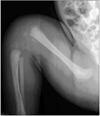Abstract
Epiphyseal fractures in neonates are rare and difficult to diagnose on simple radiographic images and objective guidelines for treatment have not yet been established. Authors performed conservative treatment for displaced distal femoral epiphyseal fracture detected on 5th day after cesarean section delivery. At 10 years of follow-up, satisfactory functional recovery was observed. Herein, we report on a case of displaced distal femoral epiphyseal birth fracture with literature reviews.
Figures and Tables
Figure 1
Radiographs of both femurs at 5 days after delivery show a Salter-Harris type 1 fracture of the right distal femoral epiphysis.

Figure 2
Ultrasonograms of both distal femurs at 5 days after delivery show posterior displacement of the distal femoral epiphysis and periosteal elevation (right side) compared with the normal contralateral side (left side).

Figure 3
Radiographs of the right femur at 8 days after delivery show callus formation on the posterior aspect of the fracture site.

References
1. Mangurten HH, Puppala B, Knuth A. Neonatal distal femoral physeal fracture requiring closed reduction and pinning. J Perinatol. 2005; 25:216–219.

2. Kang HJ, Park HW, Jahng JS, Yoo JD. Birth fracture of femur. J Korean Orthop Assoc. 1994; 29:423–430.

3. Awwad JT, Nahhas DE, Karam KS. Femur fracture during cesarean breech delivery. Int J Gynaecol Obstet. 1993; 43:324–326.

4. Basha A, Amarin Z, Abu-Hassan F. Birth-associated longbone fractures. Int J Gynaecol Obstet. 2013; 123:127–130.

5. Hägglund G, Hansson LI, Wiberg G. Correction of deformity after femoral birth fracture 16-year follow-up. Acta Orthop Scand. 1988; 59:333–335.

6. Banagale RC, Kuhns LR. Traumatic separation of the distal femoral epiphysis in the newborn. J Pediatr Orthop. 1983; 3:396–398.

7. Ekengren K, Bergdahl S, Ekström G. Birth injuries to the epiphyseal cartilage. Acta Radiol Diagn (Stockh). 1978; 19:197–204.

8. Eliahou R, Simanovsky N, Hiller N, Simanovsky N. Fracture-separation of the distal femoral epiphysis in a premature neonate. J Ultrasound Med. 2006; 25:1603–1605.





 PDF
PDF ePub
ePub Citation
Citation Print
Print





 XML Download
XML Download